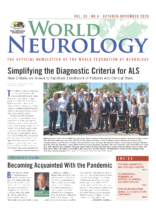A Report in Relation to World Brain Day 2020
By Dr. Marcelle Smith and Dr. Patty Francis
The African continent has been experiencing rapid changes in recent decades, with increases in life expectancy. The average healthy life expectancy increased from 46.1 years in 1990 to 55.2 in 2017.1 This is still far below the average life expectancy in high-income countries of over 70 years.2 However, this has been sufficient to increase the burden of age-related and neurodegenerative conditions such as Parkinson’s Disease (PD).

Marcelle Smith, Patty Francis
There is a belief that PD is less prevalent in African countries, but incidence or prevalence studies for Africa are lacking. Most of the available studies are specific to individual countries. Williams et al. reviewed all the literature on PD in Sub-Saharan Africa published up to May 2016. The authors observed a prevalence of PD ranging from 7/100,000 in Ethiopia to 67/100,000 in Nigeria.3
African countries experience unique challenges when it comes to diagnosis and treatment of PD. Firstly, there are far fewer neurologists in African countries compared to high-income countries, 0.03/100 000 in Africa versus 4.84/100,000 in Europe as per the WHO Neurology Atlas. The WHO recommends at least one neurologist per 100,000 people.4 Approximately 270 million Africans live in countries where there are less than five neurologists per country. Less than 50% of Sub-Saharan African countries have a neurological society.5 This limited access to neurologists leads to underdiagnosis and treatment of patients with neurological disorders such as PD.
The Neurology Association of South Africa comprises 87 neurologists in full-time private practice, 28 in full-time public sector practice and six members in limited practice. 27 registrars are currently in training. This gives a crude estimate of one neurology service provider per 400,000 population in South Africa.
Many African countries are also overburdened by malaria, TB, HIV, and other infectious outbreaks, e.g. Ebola. Hence very few facilities and resources are dedicated to non-communicable illnesses. Medication is only available to 12.5% of Africans with PD compared to 79% in Europe.5 60% of Africans live off less than $2 a day and are unable to afford the necessary treatment themselves.6
South Africa’s population was estimated at 59,308,690 people at mid-year 2020, according to UN data. Between 16-17% of these have private medical insurance, while the rest are dependent on state facilities for health care. Only three PD medications are available in state hospitals at present: levodopa, amantadine, and dopamine agonists. South Africa’s largest private medical funder’s formulary includes biperiden, pramipexole, amantadine, levodopa/decarboxylase inhibitor, and rasagiline.
It is estimated that over 160,000 patients with PD have had deep brain stimulation (DBS) surgery worldwide. This is increasing at a rate of approximately 12,000 per year.7 Three tertiary state neurological centers in South Africa are equipped to perform DBS but still struggle with funding for devices. Four private sector practices offer DBS, although these are general neurology practices with a special interest in movement disorders. No singular movement disorders center exists due to the absolute necessity to cover the entire spectrum of neurology given the ratio of neurologist to patients.
In a recent survey, 74% of South African neurologists report they have referred patients for DBS for the management of a movement disorder.8 Roughly, only one in four (27.37%) neurologists felt they had enough knowledge of, and experience with, the indications for referral for DBS.8 Most South African neurologists refer to the few available DBS centers for Parkinson’s Disease (61.05%).8 However, one of these centers reported performing only five procedures over the last five years. Adequate treatment may allow PD sufferers to continue working and providing for their families for longer.
Most PD sufferers present with the tremor predominant phenotype, which is most common in high-income countries as well. There are, however, certain clinical characteristics unique to African cohorts. In 2016, Mahne et al. from South Africa demonstrated that the akinetic-rigid variant is encountered more frequently in Black patients compared to white patients and can be found in up to a third of all patients.9 This result was replicated by Smith and Modi in a larger cohort. The authors further demonstrated that Black patients appear to develop PD symptoms at an earlier age and develop cognitive impairment more frequently than their American and European counterparts.10 A recent study out of Ethiopia by Melke et al. has also demonstrated a higher prevalence of Parkinson’s disease-related sleep disorders compared to high-income countries.11
African populations have greater levels of genetic diversity and population substructure compared to non-African populations. Africans have also developed many genetic adaptations that have evolved in response to factors such as diverse climates and exposure to infective diseases.12 This makes Africa a prime place to study genetic diversity and its impact on different diseases. In the last two decades, research of PD genetics in Sub-Saharan Africa has gained momentum. In 2009, Bardien et al. concluded that mutations in the Parkin gene, a common cause of genetic PD worldwide, were not an important cause of PD in South Africa.13 The G2019S mutation in the LRRK2 gene is the most common mutation associated with PD. However, a 2019 study from Du Toit et al, revealed that none of the 91 Black South African participants in their study had this mutation.14 This shows that some of the most common PD-associated genetic mutations globally are not truly relevant in Sub-Saharan African populations. The mutations specific to PD in this populations have yet to be discovered and hold much potential for further research.
The dearth of genetic studies in African countries can, like many other problems on the continent, be attributed to a scarcity of resources. An in-depth look into PD genetics may provide answers to whether characteristics specific to PD in African countries does in fact have a genetic and ethnic foundation, or if it is related to poverty and other challenges experienced by low-income and under-resourced populations.
The amount of PD research in African countries has increased significantly in the last two decades; however, the studies have not been directly comparable because of inconsistence among study designs.15 As African neurologists we need to strive for collaboration between different countries across the continent to find solutions to our continent’s unique challenges.
GBA mutations have emerged as the most common risk factor in PD.16 Some of the clinical features including early age of onset and cognitive impairment are also more common in patients of African origin compared to Caucasians. A genetic study investigating the prevalence of the GBA mutation in PD patients in Africa may yield interesting results.
Academic centers across Africa are collaborating more and more with one another as well as overseas centers through shared congresses and research. An example of this is the combined annual meeting of the Neurological Association of South Africa and the African Academy of Neurology in 2019. Collaboration is the key to improving care for our continent’s Parkinson’s disease population and to better understand the unique aspects of Parkinson’s disease in Africa. •
Dr. Marcelle Smith, MBChB (Stell), MMEDNeurol (Wits), FCNeurol (SA), Wits Donald Gordon Medical Center and Sandton Mediclinic, Johannesburg, South Africa.
Dr. Patty Francis, BScHONS (UCT), MBChB (WITS), FCNeurol (SA), neurology consultant, Private Practice Netcare Umhlanga Hospital, Durban, South Africa.
References:
- Wiysonge, C S. People in Africa live longer. But their health is poor in those extra years.
- Duffin, E. (2019). Life expectancy in Europe in 2019, Statista.com.
- Williams, U. et al (2018). Parkinson’s Disease in Sub-Saharan Africa: A Review of Epidemiology, Genetics and Access to care, J Mov Disord, 11(2), pp.53-64
- WHO. (2004). Neurology atlas, Country resources for neurological disorders [online]. Available from who.int
- Bower, J H. et al (2014). Addressing neurologic needs in sub-saharan Africa: An opportunity for multisociety cooperation, Neurology, 83(13), pp. 1270-1209.
- Dotchin, C.L., et al (2007). The challenge of Parkinson’s Disease in Africa, Age and Ageing, 36(2), pp.122-127.
- Lee, DJ et al (2019). Current and future directions of deep brain stimulation forneurological and psychiatric disorders, J Neurosurg, 131, pp.333-342.
- Huth , M. B. et al (2019). South African Neurology Survey 2019 Johannesburg: Neurological Association of South Africa.
- Mahne, A.C. et al (2016). Clinical findings and genetic screening for copy number variation mutations in a cohort of South African patients with Parkinson’s Disease, SAMJ, 206(6)
- Smith, M and Modi, G. (2016).The clinical profile of idiopathic Parkinson’s Disease in a South African hospital complex- the influence of ethnicity and gender, African Journal of Neurosciences, 35(1)
- Melka, D et al (2019). Prevalence of sleep disorders in Parkinson’s Disease patients in two neurology referral hospitals in Ethiopia, BMC Neurology, 19(205)
- Campbell, M. C. and Tishkoff, S. A. (2010). African Genetic Diversity: Implications for Human Demographic History, Modern Human Origins, and Complex Disease Mapping, Annu Rev Genomics Hum Genet, 9, pp.403-433.
- Bardien,S et al (2009). Molecular analysis of the parkin gene in South Africa patients diagnosed with Parkinson’s disease, Parkinsonism Relat Disord, 15(2),pp.116-21
- Du Toit,N. (2019). Frequency of LRRK2 G2019S mutation in South African patients with Parkinson’s Disease, Neurogenetics, 20(4), pp.215-218.
- Oluwole, O G. et al (2018). Parkinson’s Disease in Nigeria: A review of published studies and recommendations for future research, J Mov Disord, 11(2), pp. 53-64.
- Barkhuizen, M. et al (2016). Advances in GBA-associated Parkinson’s Disease- Pathology, presentation and therapies, Neurochemistry international, 93, pp.6-25
